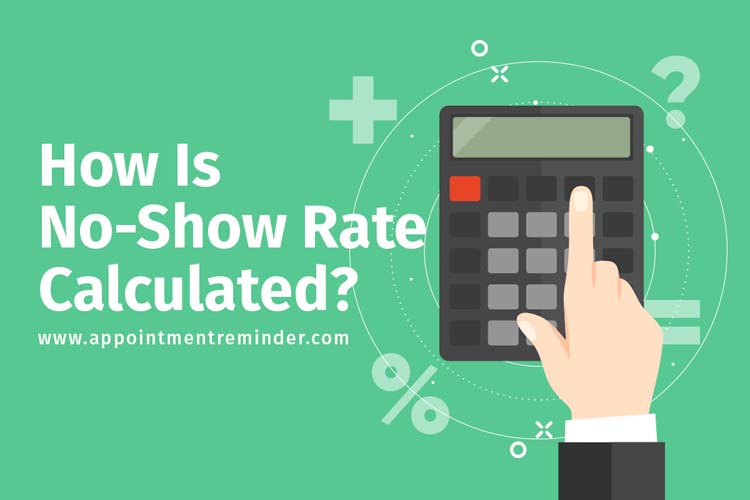
ou have a client booked for 9 a.m. on a Tuesday. You arrive at your office a half an hour early to prepare for the client’s arrival and wait for them well past the appointed hour. When they do not show up at 9 a.m., you give them another twenty minutes before beginning work on another project.
How would you, then, calculate that time in your no-show rate? And more importantly, why is it essential to do so?
As Benjamin Franklin said, “lost time is never found again.”
Unlike other elements of our lives, we cannot recover the lost opportunity of time, and in business, the lost opportunity of an appointment slot that goes unfilled. Each unfilled appointment slot in a schedule is a lost opportunity for a business to make money.
A no-show slot is even more damaging. A no-show means that the time was assigned to a person who did not show up, and therefore did not contribute to the businesses’ bottom line, and additionally prevented that time from being given to someone who would have added to the company’s revenue stream.
For the health of your business, seeing 100% of the appointment slots filled with paying clients should be your goal. Full schedules mean a steady stream of income and a healthy bottom line. This is why it’s important to understand exactly how much no-shows may be costing you.
Unfortunately, no business can boast a 0% rate of no-shows. However, many can say that they have a lower rate than other businesses in their field. These successful businesses have gotten to where they are by understanding their situation and addressing the underlying issues. You can’t take on the problem if you don’t have all the data. Here’s how to do it:
The first step in calculating your no-show rate is to find your average number of daily no-show appointments. It’s important to find the average number of daily no-shows: no one day is going to give you an overall view of what is going on.
Most experts recommend that you generate reports on no-shows monthly. Keep track of no-shows daily, and then compile those into monthly reports that show the average number of no-shows per day.
(As a note, it’s important to keep track of those that are true no-shows, and not count empty slots that are actually appointments that were rescheduled).
The second step is to find the average number of daily appointments that you book. Again, you want the average number over the course of the month. When you generate your monthly reports about the average number of no-shows per day in each month, make sure to also generate a report about the average number of appointments per day.
Once you have these two numbers as averages per day on a monthly basis, divide the average number of daily no-show appointments by the average number of scheduled appointments.
As an example, let’s say that in a given month, your business averaged 15 scheduled
appointments a day, and averaged 1 no-show per day.
1 ÷ 15 =.06
So your no-show rate is 6%. Many businesses have no-show rates somewhere between
2% and 15%, numbers which vary greatly based on the location of the business (urban, suburban or rural) and the type of business (legal, medical, beauty/salon, etc.).
Once you know your no-show rate, you can take the time to estimate how much each client no-show costs you and your business. This can help you both see in real numbers the impact that no-shows have (a way to incentivize you to make the changes necessary to reduce no-shows) and can help you see the way forward to making changes.
There is more than one way a no-show hurts your bottom line. Here are the elements that you should take into account when calculating the cost of each no-show:
Take the average number of no-shows per month (you should have that data from the work you did above) and multiply that by the average cost of an appointment at your business.
If, for example, an average appointment at your business costs $200, and you are averaging 20 no-shows per month, those no-shows are costing you $4,000 a month.
When a client doesn’t show up for an appointment, it costs more than just the direct hit of the lost revenue that they would have paid you. The client not showing up creates an inaccurate schedule full of holes that in turn makes it difficult to create an accurate staffing schedule. If you are staffing based on client needs (staffing hours based on when clients will be there), this costs you money in payroll.
When you are dealing with no-shows, your staff may then also spend time trying to rebook the open time slot, time that could have been spent on other tasks. This cost is harder to calculate but should not be overlooked.
When you are faced with many or multiple no-shows, you and your staff may be tempted to do one of two things. First, you may wait for the patient or client to show up in order to not lose the revenue of the appointment, thereby increasing the wait time for the clients who were booked after.
Secondly, you may be tempted to begin overbooking or double-booking in anticipation of no-shows so as not to lose revenue. Both of these have the potential to do real damage to your relationship with your clients who do show up. If you do not treat your reliable clients well, you risk losing future revenue from them.
In order to run an efficient and profitable business, it’s essential to understand your no-show rate and how it affects you and your clients.
Only once you have this information can you move forward and take the action needed to reduce no-shows and maximize your time.